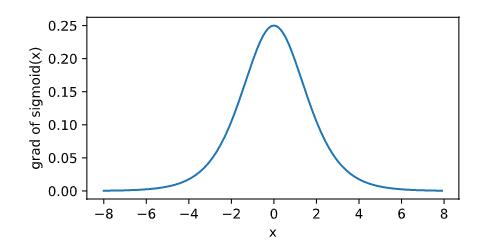多层感知机
%matplotlib inline
import torch
import numpy as np
import matplotlib.pylab as plt
import sys
sys.path.append("..")
import d2lzh_pytorch as d2l
print(torch.__version__)
1.11.0+cu113
激活函数
def xyplot(x_vals, y_vals, name):
d2l.set_figsize(figsize=(5, 2.5))
d2l.plt.plot(x_vals.detach().numpy(), y_vals.detach().numpy())
d2l.plt.xlabel('x')
d2l.plt.ylabel(name + '(x)')
ReLU函数
x = torch.arange(-8.0, 8.0, 0.1, requires_grad=True)
y = x.relu()
xyplot(x, y, 'relu')

y.sum().backward()
xyplot(x, x.grad, 'grad of relu')

sigmoid函数
y = x.sigmoid()
xyplot(x, y, 'sigmoid')

x.grad.zero_()
y.sum().backward()
xyplot(x, x.grad, 'grad of sigmoid')

tanh函数
y = x.tanh()
xyplot(x, y, 'tanh')

x.grad.zero_()
y.sum().backward()
xyplot(x, x.grad, 'grad of tanh')

1.多层感知机的从零开始实现
import torch
import numpy as np
import sys
sys.path.append("..") # 为了导入上层目录的d2lzh_pytorch
import d2lzh_pytorch as d2l
print(torch.__version__)
1.11.0+cu113
获取和读取数据
batch_size = 256
train_iter, test_iter = d2l.load_data_fashion_mnist(batch_size)
定义模型参数
num_inputs, num_outputs, num_hiddens = 784, 10, 256
W1 = torch.tensor(np.random.normal(0, 0.01, (num_inputs, num_hiddens)), dtype=torch.float)
b1 = torch.zeros(num_hiddens, dtype=torch.float)
W2 = torch.tensor(np.random.normal(0, 0.01, (num_hiddens, num_outputs)), dtype=torch.float)
b2 = torch.zeros(num_outputs, dtype=torch.float)
params = [W1, b1, W2, b2]
for param in params:
param.requires_grad_(requires_grad=True)
定义激活函数
def relu(X):
return torch.max(input=X, other=torch.tensor(0.0))
定义模型
def net(X):
X = X.view((-1, num_inputs))
H = relu(torch.matmul(X, W1) + b1)
return torch.matmul(H, W2) + b2
定义损失函数
loss = torch.nn.CrossEntropyLoss()
训练模型
num_epochs, lr = 5, 100.0
d2l.train_ch3(net, train_iter, test_iter, loss, num_epochs, batch_size, params, lr)
epoch 1, loss 0.0030, train acc 0.714, test acc 0.753 epoch 2, loss 0.0019, train acc 0.821, test acc 0.777 epoch 3, loss 0.0017, train acc 0.842, test acc 0.834 epoch 4, loss 0.0015, train acc 0.857, test acc 0.839 epoch 5, loss 0.0014, train acc 0.865, test acc 0.845
2.多层感知机的简洁实现
import torch
from torch import nn
from torch.nn import init
import numpy as np
import sys
sys.path.append("..")
import d2lzh_pytorch as d2l
print(torch.__version__)
1.11.0+cu113
定义模型
num_inputs, num_outputs, num_hiddens = 784, 10, 256
net = nn.Sequential(
d2l.FlattenLayer(),
nn.Linear(num_inputs, num_hiddens),
nn.ReLU(),
nn.Linear(num_hiddens, num_outputs),
)
for params in net.parameters():
init.normal_(params, mean=0, std=0.01)
读取数据并训练模型
batch_size = 256
train_iter, test_iter = d2l.load_data_fashion_mnist(batch_size)
loss = torch.nn.CrossEntropyLoss()
optimizer = torch.optim.SGD(net.parameters(), lr=0.5)
num_epochs = 5
d2l.train_ch3(net, train_iter, test_iter, loss, num_epochs, batch_size, None, None, optimizer)
epoch 1, loss 0.0031, train acc 0.703, test acc 0.757 epoch 2, loss 0.0019, train acc 0.824, test acc 0.822 epoch 3, loss 0.0016, train acc 0.845, test acc 0.825 epoch 4, loss 0.0015, train acc 0.855, test acc 0.811 epoch 5, loss 0.0014, train acc 0.865, test acc 0.846








Comments NOTHING